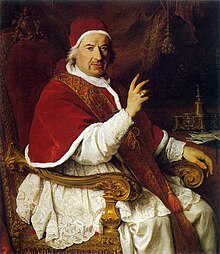Pope Benedict XIV
This article needs additional citations for verification. (June 2010) |
Pope Benedict XIV | |
|---|---|
 | |
| Papacy began | 17 August 1740 |
| Papacy ended | 3 May 1758 (17 years, 259 days) |
| Predecessor | Clement XII |
| Successor | Clement XIII |
| Orders | |
| Consecration | 16 July, 1724 by Pope Benedict XIII |
| Created cardinal | 30 April, 1728 |
| Personal details | |
| Born | Prospero Lorenzo Lambertini 31 March 1675 |
| Died | 3 May 1758 (aged 83) Rome, Papal State |
| Other popes named Benedict | |
| Papal styles of Pope Benedict XIV | |
|---|---|
 | |
| Reference style | His Holiness |
| Spoken style | Your Holiness |
| Religious style | Holy Father |
| Posthumous style | None |
Pope Benedict XIV (31 March 1675 – 3 May 1758), born Prospero Lorenzo Lambertini, was Pope from 17 August 1740 to 3 May 1758.
Life
Lambertini was born into a noble family of Bologna, which was at that time the second largest city in the Papal States. He was created Cardinal-Priest of Santa Croce in Gerusalemme on 10 May 1728 and was elected Pope in 1740. The conclave that elected him had lasted for six months, and he is reported to have said to the cardinals: "If you wish to elect a saint, choose Gotti; a statesman, Aldrovandi; an honest man, me".[2] His Papacy began in a time of great difficulties, chiefly caused by the disputes between Catholic rulers and the Papacy about governmental demands to nominate bishops rather than leaving the appointment to the Church. He managed to overcome most of these problems — the Holy See's disputes with the Kingdom of Naples, Sardinia, Spain, Venice, and Austria were settled.
He had a very active papacy, reforming the education of priests, the calendar of feasts of the Church, and many papal institutions. Perhaps the most important act of Benedict XIV's pontificate was the promulgation of his famous laws about missions in the two bulls, Ex quo singulari and Omnium solicitudinum. In these bulls he ruled on the custom of accommodating Christian words and usages to express non-Christian ideas and practices of the native cultures, which had been extensively done by the Jesuits in their Indian and Chinese missions.
An example of this is the statues of ancestors - there had long been uncertainty whether honour paid to one's ancestors was unacceptable 'ancestor worship,' or if it was something more like the Catholic veneration of the saints. This question was especially pressing in the case of an ancestor known not to have been a Christian. The choice of a Chinese translation for the name of God had also been debated since the early 17th century. Benedict XIV denounced these practices in these two bulls. The consequence of this was that many of these converts left the Church.

On 22 December 1741, Benedict XIV promulgated the papal bull "Immensa Pastorum principis" against the enslavement of the indigenous peoples of the Americas and other countries.
Given at Rome, at St. Mary Major, under the Ring of the Fisherman, on May 18, 1743, Benedict XIV spoke to the Venerable Brothers, Archbishops and Bishops of the Kingdom of Poland on his position of marriage:[3]
He communicated his dissatisfaction of dissolution of Christian marriages, even long-stable ones, by the Ecclesiastical Courts of Poland without due cause or in violation of canon law. He requested the Brothers, Archbishops and Bishops of the Kingdom of Poland to watch over the flock entrusted to their care.
Benedict XIV was also responsible, along with Cardinal Passionei, for beginning the catalogue of the Vatican Library. Benedetto, Duke of Chablais, a military commander of the French Revolution and member of the House of Savoy (rulers of the kingdom of Sardinia) was named after him. Infanta Benedita of Portugal was also named after him.

See also
- Chinese Rites controversy
- Suppression of the Jesuits
- Castrato - Benedict XIV was one of the first Popes to voice displeasure regarding the use of castrated males in Church choir services.
- Vix Pervenit
Footnotes
- ^ Pope Benedict X is now considered an antipope. At the time, however, this status was not recognised and so the pontiff the Roman Catholic church officially considers the tenth true Pope Benedict took the official number XI, rather than X. This has advanced the numbering of all subsequent Popes Benedict by one. Popes Benedict XI-XVI are, from an official point of view, the tenth through fifteenth popes by that name.
- ^ Michael J. Walsh, Pocket Dictionary of Popes (2006) p. 21
- ^ Benedict, XIV; and Hausmann, Bernard A. S. J. . "NIMIAM LICENTIAM: To Bishops of Poland: On Validity of Marriages (1743 May 18)". papaltheology.org Pierian Press. 18 May 1743. Retrieved 2 September 2010.
